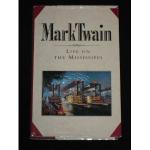of dim children, parents, cousins, aunts, and friends,
in all attitudes but customary ones; no templed portico
at back, and manufactured landscape stretching away
in the distance—that came in later, with
the photograph; all these vague figures lavishly chained
and ringed—metal indicated and secured from
doubt by stripes and splashes of vivid gold bronze;
all of them too much combed, too much fixed up; and
all of them uncomfortable in inflexible Sunday-clothes
of a pattern which the spectator cannot realize could
ever have been in fashion; husband and wife generally
grouped together—husband sitting, wife
standing, with hand on his shoulder—and
both preserving, all these fading years, some traceable
effect of the daguerreotypist’s brisk ’Now
smile, if you please!’ Bracketed over what-not—place
of special sacredness—an outrage in water-color,
done by the young niece that came on a visit long
ago, and died. Pity, too; for she might have repented
of this in time. Horse-hair chairs, horse-hair
sofa which keeps sliding from under you. Window
shades, of oil stuff, with milk-maids and ruined castles
stenciled on them in fierce colors. Lambrequins
dependent from gaudy boxings of beaten tin, gilded.
Bedrooms with rag carpets; bedsteads of the ‘corded’
sort, with a sag in the middle, the cords needing
tightening; snuffy feather-bed—not aired
often enough; cane-seat chairs, splint-bottomed rocker;
looking-glass on wall, school-slate size, veneered
frame; inherited bureau; wash-bowl and pitcher, possibly
—but not certainly; brass candlestick, tallow
candle, snuffers. Nothing else in the room.
Not a bathroom in the house; and no visitor likely
to come along who has ever seen one.
That was the residence of the principal citizen, all
the way from the suburbs of New Orleans to the edge
of St. Louis. When he stepped aboard a big fine
steamboat, he entered a new and marvelous world:
chimney-tops cut to counterfeit a spraying crown of
plumes—and maybe painted red; pilot-house,
hurricane deck, boiler-deck guards, all garnished with
white wooden filigree work of fanciful patterns; gilt
acorns topping the derricks; gilt deer-horns over
the big bell; gaudy symbolical picture on the paddle-box,
possibly; big roomy boiler-deck, painted blue, and
furnished with Windsor armchairs; inside, a far-receding
snow-white ‘cabin;’ porcelain knob and
oil-picture on every stateroom door; curving patterns
of filigree-work touched up with gilding, stretching
overhead all down the converging vista; big chandeliers
every little way, each an April shower of glittering
glass-drops; lovely rainbow-light falling everywhere
from the colored glazing of the skylights; the whole
a long-drawn, resplendent tunnel, a bewildering and
soul-satisfying spectacle! In the ladies’
cabin a pink and white Wilton carpet, as soft as mush,
and glorified with a ravishing pattern of gigantic
flowers. Then the Bridal Chamber—the
animal that invented that idea was still alive and




